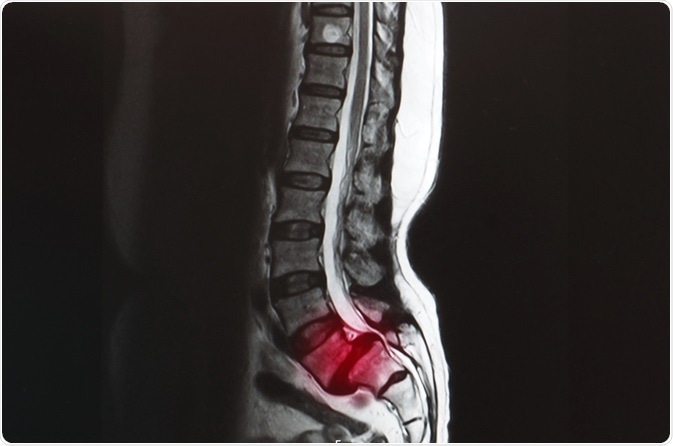The symptomatology of spondylolisthesis is highly variable between different patients with the condition. While some patients experience a significant drop in quality of life due to the severity of various symptoms, other individuals with the condition may not realize they are affected until the results are discovered in an X-ray examination.

Spondylolisthesis. Image Credit: Yok_onepiece/Shutterstock.com
The symptoms of the condition are discussed below, grouped into physical changes, lower back pain, and sensations due to the involvement of the nerves. Additionally, the onset and severity of symptoms are covered in further detail.
Physical Changes
All patients with spondylolisthesis will experience changes in the positioning of the vertebrae of the spine, displaced forward. These changes may be accompanied by resulting symptoms, such as stiffening of the back and tightening of the hamstring muscles in the legs.
As a result, many patients will notice changes in their posture and gait when walking. It often appears that the individual is leaning forward excessively and may cause the walking motion to become more mechanical, like a waddle, due to the increased need to move the hips following the reduced mobility of the legs. Some patients may find that making everyday movements, such as standing up or walking, is much more difficult to do.
Lower back pain
It is common for patients with spondylolisthesis to suffer from significant pain in the lower back as a result of the condition. This pain is typically worse when in the standing position or when partaking in physical activity, which can last for a period of days after the activity due to inflammation of related tissues.
Likewise, the pain is usually relieved when patients are able to rest and lie down, as this gives the inflamed tissues time to heal and reduces the intensity of the associated pain. This can be a significant issue, however, when a simple activity such as walking causes pain and inflammation to occur.
Nervous Sensations
In addition to general back pain, some individuals report shooting pain, often from their buttocks to the lower legs. This is likely to be caused by the involvement of the nerves as the vertebrae of the spine push against the spinal nerves in their altered position.
Similarly, sensations of tingling and numbness are often evident in the extremities of the body due to the vertebrae interfering with the nerves in the spine.
Symptom Onset and Severity
Most individuals with spondylolisthesis initially notice symptoms in adulthood. However, the symptoms commonly arise from spinal changes following an injury to the intervertebral joints between the ages of 6 and 16 years.
Not all patients with spondylolisthesis experience the same symptoms or level of inhibition to everyday activities, as both the type and severity of symptoms can vary greatly. Some individuals are not aware of the condition until an X-ray examination for another purpose reveals the abnormal positioning of the spine, characteristic of the condition.
However, other patients find that their quality of life is severely inhibited by the condition, particularly due to the pain and physical changes associated with spondylolisthesis.
References
Further Reading